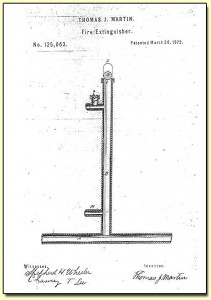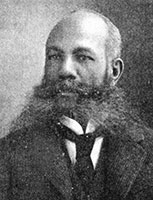Black History, Inventions

Otis Boykin
1920-1982 – An electronic scientist and inventor, Otis Boykin devised the control unit in artificial heart stimulators, invented a variable resistor device used in many guided missiles, small components such as thick-film resistors used in IBM computers, and many other devices including a burgular-proof cash register and a chemical air filter.
Starting as an assistant in a laboratory testing airplane automatic controls, Boykin was soon developing a type of resistor now used in many computers, radios, television sets and other electronically controlled devices.
Many products made from his discoveries are manufactured in Paris and throughout Western Europe. One of his products was approved for use in military hardware for the Common Market.
Black History, Inventions
 Michael Croslin held more than 40 patents for medical inventions and established his own company, Medtek Corporation. His inventions include a computerized, digital blood pressure measurement device; a refractometer (used to measure the index of refraction of a substance) that measures levels of urinary sugar and protein; and a pump that measures and dispenses intravenous medications.
Michael Croslin held more than 40 patents for medical inventions and established his own company, Medtek Corporation. His inventions include a computerized, digital blood pressure measurement device; a refractometer (used to measure the index of refraction of a substance) that measures levels of urinary sugar and protein; and a pump that measures and dispenses intravenous medications.
Born in 1933 in the U.S. Virgin Islands in Frederiksted, St. Croix, Michael Croslin was abandoned as a baby. A family named Britto gave him a home as a child and named him Miguel (later Anglicized as “Michael”). By the time he was 12, he fled the islands for the mainland United States. He worked odd jobs, living in Georgia for a time, and he obtained a brief education at a Jesuit school. He eventually wound up in Wisconsin, where he was adopted by the Croslin family. He, in turn, adopted their name.
(more…)
Black History, Inventions
 Thomas J Martin, a Black inventor, was awarded a patent for the Fire Extinguisher on March 26, 1872. His invention is listed in the U. S. Patent Office in Washington, DC under patent number115,603.
Thomas J Martin, a Black inventor, was awarded a patent for the Fire Extinguisher on March 26, 1872. His invention is listed in the U. S. Patent Office in Washington, DC under patent number115,603.
The patent refers to pipe and valves and not the wall hanging type of extinguisher that is normally displayed.

Black History, Inventions, Science

Lloyd August Hall
Born: June 20, 1894
Died: January 2, 1971
Birthplace: Elgin, Illinois
Occupation: Chemist and Inventor
Lloyd August Hall received his Bachelor of Science from Northwestern University in 1914, a Master of Science from Northwestern in 1916, and a Doctor of Science (D.Sc.) from Virginia State College in 1944. Dr. Hall has served as junior and senior Sanitary Chemist of the Department of Health laboratories for the city of Chicago, Illinois from 1915 to 1919. He also served as chief chemist for John Morrel and Company of Ottuma, Illinois (1919-1921). He was President of the Chemical Products Corporation, Chicago from 1921 to 1924. Dr. Hall served as Consultant for Griffith’s Laboratories from 1925 to 1929, later as Technical Director and Chief Chemist of Griffith’s Laboratories in Chicago, Illinois from 1929 to 1946. From 1946 to 1959 Lloyd hall served as Technical Director. (more…)
Black History, Inventions, Other

Alexander Miles
Alexander Miles, who contributed to the elevator industry, was an African-American inventor of the late 19th century who was able to transcend racial barriers in the United States.
Miles attached a flexible belt to the elevator cage, and when the belt came into contact with drums positioned along the elevator shaft just above and below the floors, it allowed the elevator shaft doors to operate at the appropriate times. The elevator doors themselves were automated through a series of levers and rollers.
Before working on elevator engineering, Miles experimented with the creation of hair products. The influence of his elevator patent is still seen in modern designs, since the automatic opening and closing of elevator and elevator shaft doors is a standard feature.
Miles, who was born in Duluth, Minnesota, designed an elevator that was able to open and close its own doors and the elevator shaft doors. When the elevator would arrive or depart from a given floor, the doors would move automatically. Previously, the opening and closing of the doors of both the shaft and the elevator had to be completed manually by either the elevator operator or by passengers, contributing greatly to the hazards of operating an elevator.

Black History, Inventions

The drawing of the Seed-Planter by Blair used on the patent application in 1836.
Henry Blair, one of the earliest black inventors to receive a patent, was born in Montgomery County, Md. around 1807. Little is known about his personal life. Blair is assumed to have been free since slaves could not legally obtain patents. He received two patents, one in 1834 for his seed planter and another in 1836 for a cotton planter. For many years he was thought to be the first black American to receive a U.S. patent. Later,it was recognized that Thomas L. Jennings received his patent in 1821 for the invention of the dry cleaning process. Many people are unaware of this and still cite Henry Blair as the first black patent holder. (more…)

 Michael Croslin held more than 40 patents for medical inventions and established his own company, Medtek Corporation. His inventions include a computerized, digital blood pressure measurement device; a refractometer (used to measure the index of refraction of a substance) that measures levels of urinary sugar and protein; and a pump that measures and dispenses intravenous medications.
Michael Croslin held more than 40 patents for medical inventions and established his own company, Medtek Corporation. His inventions include a computerized, digital blood pressure measurement device; a refractometer (used to measure the index of refraction of a substance) that measures levels of urinary sugar and protein; and a pump that measures and dispenses intravenous medications.



